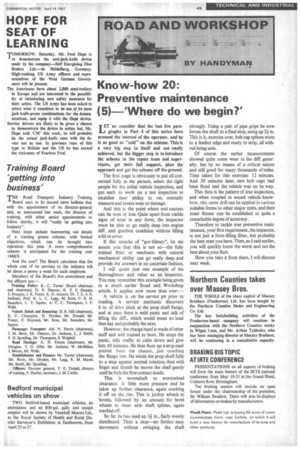Preventive maintenance (5) 'Where do we begin?'
Page 51

If you've noticed an error in this article please click here to report it so we can fix it.
y ET us consider that the last few para
graphs in Part 4 of this series have aroused the interest of the operator, and he is as good as "sold" on the scheme. This is a very big step in itself and not easily achieved, but the bigger step is to introduce the scheme to the repair team and supervisors, get their full support, plan the approach and get the scheme off the ground.
The first stage is obviously to put all concerned fully in the picture, select the right people for the initial vehicle inspection, and put each to work on a test inspection to establish their ability to vet, mentally measure and assess wear or damage.
And this is the point where real success can be won or lost. Quite apart from visible signs of wear in any form, the inspector must be able to go really deep into engine duff, and gearbox condition without lifting a lid or cover.
If this smacks of "gor-blimey", let me assure you that this is not so—the fully trained fitter or mechanic with natural mechanical ability can go really deep and provide the answers in no uncertain fashion.
I will quote just one example of his thoroughness and value as an inspector. You may remember this example being given in a much earlier Road and Workshop article. It applies now more than ever:— A vehicle is on the service pit prior to loading. A service mechanic discovers 6 in. of drive slack at the prop shaft flange, and at once there is mild panic and talk of lifting the diff., which would mean no load that day and probably the next.
However, the charge hand is made of other stuff and well trained to boot. He stops the panic, tells traffic to calm down and give him 10 minutes. He then fixes up a strip steel pointer from the chassis, just touching the flange rim. He winds the prop shaft fully to a stop against normal rotation, then with finger and thumb he moves the shaft gently until he feels the first contact inside.
This is wormshaft to wormwheel clearance. A little more pressure and he takes up further clearance, again marking it off on the rim. This is jockey wheels to bevels, followed by an amount for bevel wheels to inner axle shaft splines, again marked off.
So far he has used up 3f in., fairly evenly distributed. Then a stop—no further easy movement without swinging the shaft strongly. Using a pair of pipe grips he now forces the shaft to a final stop, using up 21 in. This is it, exercise over, hub cap splines worn to a feather edge and ready to strip, all without being seen.
Of course the earlier measurements showed quite some wear in the cliff, generally, but by no means of a critical nature and still good for many thousands of miles. Time taken for this exercise: 12 minutes. And 30 minutes later, new hub caps had been fitted and the vehicle was on its way.
This then is the pattern of true inspection, and when coupled to sound vehicle knowhow, this same drill can be applied in various suitable forms to other major units, and their inner fitness can be established to quite a remarkable degree of accuracy.
Therefore to tackle true preventive maintenance, your first requirement, the inspector, is not just a form-filling fitter, but probably the best man you have. Then, as I said earlier, you will quickly know the worst and not the best about your fleet.
How you take it from there, I will discuss next week.
























































































































